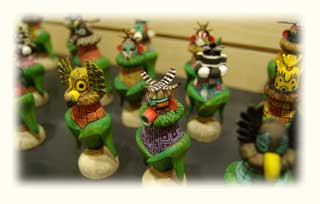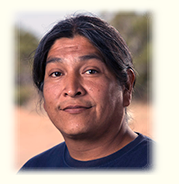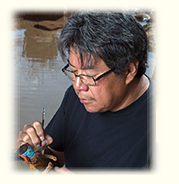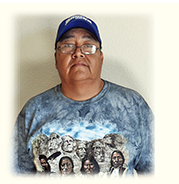Carvings
Katsina Dolls
Small brightly painted wooden dolls are what come to mind when people hear the word Katsina. These dolls are actually called tithu by the Hopi people. They are referred to as katsintithu when a more specific term is needed.
 Katsina primarily refers to the supernatural beings who are believed to visit Hopi villagers during half of the year. Katsinas have the power to bring rain, exercise control over the weather, help in many of the everyday activities of the villagers, punish offenders of ceremonial or social laws, and, in general, to function as messengers between the spiritual domain and mortals. Katsinas are spiritual messengers.
Katsina primarily refers to the supernatural beings who are believed to visit Hopi villagers during half of the year. Katsinas have the power to bring rain, exercise control over the weather, help in many of the everyday activities of the villagers, punish offenders of ceremonial or social laws, and, in general, to function as messengers between the spiritual domain and mortals. Katsinas are spiritual messengers.
The tithu are given to girls and new brides on dance days during which gifts are given by the Katsinas. The children take them home and through them learn what each Katsina looks like. The tithu are used to teach children about the different Hopi Katsinas.
From a Hopi perspective, tithu that are carved by people who are not Hopi are not katsina dolls. A Hopi carver tries to fashion a doll that conforms . . . to the attributes of the Katsina, as taught in religious training. A skilled carver knows the attributes and distinctive characteristics of a particular Katsina and conveys the essence of the Katsina in the carved figure . . . Dolls carved by those not familiar with Hopi religion do not convey the proper feeling and, to Hopis, they look wrong.
Nuvadi Dawahoya

Second Mesa
Shungopovi Village
Carving
Primary Phone:(928)313-4001
Secondary Phone:(928)401-8387
P.O. Box 625, Polacca, AZ 86042
This email address is being protected from spambots. You need JavaScript enabled to view it.
Michael George

Third Mesa
Hotevilla Village
Carving
(480)512-9675
P.O. Box 864, Tuba City, AZ 86045
This email address is being protected from spambots. You need JavaScript enabled to view it.
Wally Grover

First Mesa
Tewa Village
Carving
(928) 613-8452
P.O. Box 671, Polacca, AZ 86042
This email address is being protected from spambots. You need JavaScript enabled to view it.
Many people throughout the world practice many different forms of art. Forms of art may be foreign to a person, but some forms of art may be part of their very own culture. Wally Grover, Hopi/Tewa, from Polacca, Arizona practices a form of art native to his culture. He is a self-employed kachina doll/sculpture carver and provides for his family with his creative work.
Wally was introduced to this form of art when he was eighteen years old by his brother-in-law, Marlon Huma whom is also a well-known kachina doll carver. Wally carves using the roots of a cottonwood tree. His tools consist of a pocketknife, coping saw, wood burner, sandpaper, paintbrushes, linseed oil and acrylic paint.
Wally has attended many Native American art shows throughout Arizona.






